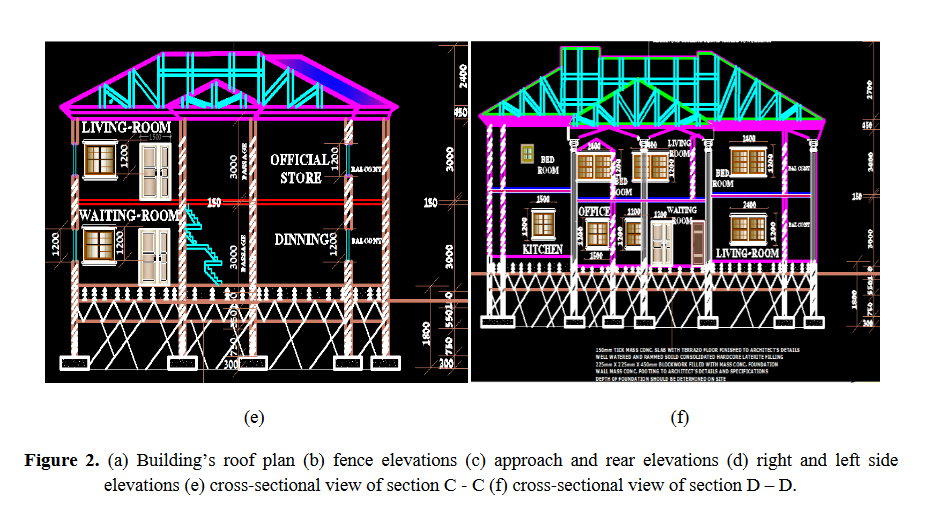Analysis and Design of Building’s Structural Members (Slabs and Beams) using Microsoft Excel and AUTOCAD Software: A Case Study of MARCGSO’ Building
DOI:
https://doi.org/10.53848/ssstj.v10i2.389Keywords:
Microsoft Excel, Structural analysis, Design code, Design errorAbstract
The frequent collapse of concrete structures (Buildings, Bridges and Culverts) these days in the global construction industries has led to claiming of many innocent lives. From the literature perspective, the observed major causes of this failure are the errors developed from the programmed structural software; the method used in running the software, its usage error during the analysis and design of structural members; and possibly, error committed by unskill personnel while using the structural software. Allowing the continuity of these errors in the construction industries will cause greater damages to lives and properties globally, thus; a more accurate and reliable design software has to be developed to eradicate errors occurrence in structural design. The results of this investigation proved that Microsoft Excel sheet is accurate for structural members’ analysis and design; good for accurate calculation in designing, it can be access quick; so reliable, and error free. Its application in construction industries will bring accuracy and stability to designed structures, and more lives will be saved. As a case study, the architectural plans of Maryland Catholic Grammar School, Ogbomoso (MARCGSO)’s principal lodge building was used as a prototype to show how efficient is Microsoft Excel in structural analysis. At MARCGSO, this has been tested and found reliable. During the investigation, the structural details of the designed concrete structural members were carried out using AUTOCAD software. Analysis and design of members were carried out from the basic principle of structural design using BS 8110 part 1:1999. The result shows that, Microsoft Excel and BS 8110 part 1:1999 code are the best design tools needed for analysis and design of structural members. It is very fast, accurate and error free. Also, the output of analysis carried out using Microsoft Excel are traceable, amendable and reliable, thus, its application in designing will prevent sudden structural failure. Likewise, it is very easy for young and structural engineers to operate, thus, its application can be done by: open a fresh Microsoft Excel sheet, get BS 8110 part 1:1999 code of structural design, prepare a general arrangement of architectural plan of structure to design, then follow the step by step of designing stated in this study. It required no application download or software purchase. In conclusion, the use of Microsoft Excel in structural analysis and designing will save many lives and prevent sudden collapse of structures resulting from wrong code or software error.
References
British Standard (BS) 8110-1. (1997). Structural use of concrete. Part 1: Code of practice for design and construction. London: British Standards Institution.
Civil Engineering X. (2022). Types of structural members and supports. Retrieved from https://civilengineeringx.com/structuralanalysis/structural-steel/types-of-structuralmembers-and-supports/
De Quiros, A. C. B., Lopez, R., Aranda-Mena, G., & Edwards, P. (2008). Human reliability as a source of error in research. In A. Dainty (Ed.), Procs 24th Annual ARCOM Conference (pp. 687-696). Cardiff, UK.
E-SUB Construction Software. (2018). What is structural design in civil engineering? Retrieved from https://esub.com/blog/what-is-structuraldesign-in-civil-engineering/
Fire Engineering. (2010). Building Construction: Understanding structural loads and loading. Retrieved from https://www.fireengineering.com/firefighting/building-construction-understanding-loads-andloading-2/
Gupta, S. (2021). Structural analysis and design of multistorey reinforced concrete building using STAAD.Pro. Retrieved from
Harle, S. M. (2017). Analysis by STAAD-PRO and design of structural elements by MATLAB. Journal of Asian Scientific Research, 7(5), 145-164. doi:10.18488/journal.2.2017.75.145.164
Kilani, A. J., Adeleke, O., & Fapohunda, C. A. (2022). Application of machine learning models to investigate the performance of concrete reinforced with oil palm empty fruit brunch (OPEFB) fibers. Asian Journal of Civil Engineering, 23, 299-320.doi:10.1007/s42107-022-00424-0
Law-Insider. (2021). Structural member definition. Retrieved from https://www.lawinsider.com/dictionary/structural-members
Lopez, R., Love, P. E. D., Edwards, D. J., & Davis, P.R. (2010). Design error classification, causation, and prevention in construction engineering. Journal of Performance of Constructed Facilities,24(4), 399-408.doi:10.1061/(ASCE)cf.1943–5509.0000116
Mrema, G. C., Gumbe, L. O., Chepete, H. J., & Agullo, J. O. (2012). Rural structures in the tropics: Design and development. Italy: FAO.
Musa, S., & Obaju, B. (2016). Effects of design error on construction project. International Journal of Scientific and Engineering Research, 7(2),1099-1114.
Navaee, S. (2003). Utilization of Excel in solving structural analysis problems. Paper presented at 2003 Annual Conference, Nashville, Tennessee.
Ondrej. (2011). Error codes and error descriptions:Technical knowledge base. Retrieved from https://wiki.csiamerica.com/pages/viewpage.action?pageId=7635149
Peansupap, V., & Ly, R. (2015). Evaluating the impact level of design errors in structural and other building components in building construction projects in Cambodia. Procedia Engineering,123, 370-378. doi:10.1016/j.proeng.2015.10.049
Ram, J. (2020). Why beams and columns are important for building construction? Retrieved from https://www.ramjackokc.com/articles/why-beams-and-columns-are-important-for-building-construction
Reichart, G. (1988). How to reduce design and construction errors. Nuclear Engineering and Design, 110(2), 251-254.
Saha, S., Ali, M. N., Chisanga, W. K., & Yasin, A.(2021). Design and analysis of multistory (G +14) residential building using Staad.Pro & Autocad. International Journal of Scientific Research in Civil Engineering, 5(3), 70-82.doi:10.32628/IJSRCE215311
Structural Design. (2023). Design and development in rural structures. Retrieved from https://www.fao.org/3/i2433e/i2433e04.pdf
Survey Developer. (2023). Fiware Orion runtime error. Retrieved from https://stackoverflow.com/questions/51140211/length-of-dbname-is-max-10

Downloads
Published
How to Cite
Issue
Section
License
Copyright (c) 2023 Suan Sunandha Rajabhat University

This work is licensed under a Creative Commons Attribution 4.0 International License.











